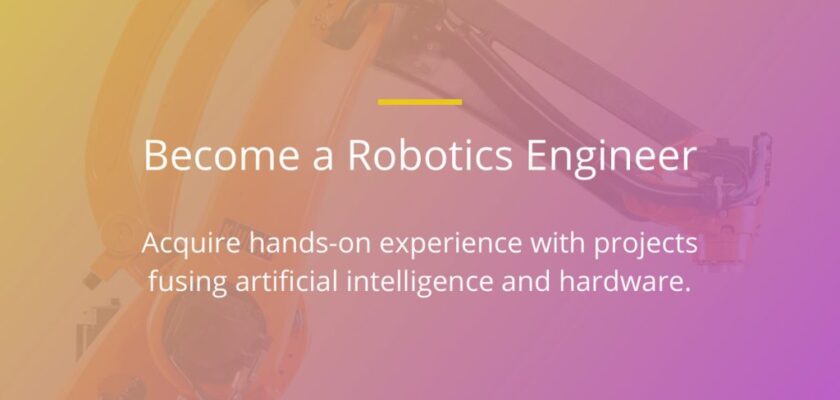Download and Learn Become a Robotics Software Engineer Udacity Nanodegree Course 2023 for free with google drive download link.
Build hands-on projects to acquire core robotics software engineering skills: ROS, Gazebo, Localization, Mapping, SLAM, Navigation, and Path Planning.
What You’ll Learn in Become a Robotics Software Engineer Nanodegree

Robotics Software Engineer
4 months to complete
Begin your exploration into the world of robotics software engineering with a practical, system-focused approach to programming robots using the ROS framework and C++. In addition, learn and apply robotics software engineering algorithms such as localization, mapping, and navigation.
Become a Robotics Software Engineer Nanodegree Intro Video:
Prerequisite knowledge
To optimize your chances of success in the Robotics Software Engineer Nanodegree program, we’ve created a list of prerequisites and recommendations to prepare you for the program curriculum.
To optimize your chances of success in the Robotics Software Engineer Nanodegree program, we’ve created a list of prerequisites and recommendations to help prepare you for the program curriculum. You should have the following knowledge:
- Advanced knowledge in any object-oriented programming language, preferably C++
- Intermediate Probability
- Intermediate Calculus
- Intermediate Linear Algebra
- Basic Linux Command Lines
For aspiring roboticists who currently have a limited background in programming or math, we’ve created the Intro to Self-Driving Cars Nanodegree program to help you prepare. This program teaches C++, linear algebra, calculus, and statistics.
Introduction To Robotics
Learn the essential elements of robotics, meet your instructors, and get familiar with the tools that will help you succeed in this program.
Gazebo World
Learn how to simulate your first robotic environment with Gazebo, the most common simulation engine used by Roboticists around the world.
Project – Build My World
Use Gazebo to simulate a robotic environment comprised of a building to house your future robot. Skills you will apply: Gazebo, C++ plugins.
ROS Essentials
Discover how ROS provides a flexible and unified software environment for developing robots in a modular and reusable manner. Learn how to manage existing ROS packages within a project, and how to write ROS Nodes of your own in C++.
Project – Go Chase It!
Use the Robot Operating System (ROS) to design a mobile robot. Then, house your newly-designed robot in the robotic environment you built in Project 1. You will program your robot with C++ to chase a ball through this world. Skills you will apply: catkin workspaces, ROS packages, ROS nodes, ROS launch files, RViz integration, and C++.
Localization
Learn how Gaussian filters can be used to estimate noisy sensor readings, and how to estimate a robot’s position relative to a
known map of the environment with Monte Carlo Localization (MCL).
Project – Where Am I?
Use the Monte Carlo Localization algorithm in ROS, in conjunction with sensor data and a map of the world, to estimate a mobile robot’s position and orientation so that your robot can answer the question “Where am I?” Skills you will apply: Localization algorithms: Kalman Filter and MCL, ROS parameters, ROS packages integration, C++.
Mapping and SLAM
Learn how to create a Simultaneous Localization and Mapping (SLAM) implementation with ROS packages and C++. You’ll achieve this by combining mapping algorithms with what you learned in the localization lessons.
Project – Map My World
Simultaneous Localization and Mapping (SLAM) can be implemented in a number of ways depending on the sensors used via various ROS packages. Use a ROS SLAM package and simulated sensor data to create an agent that can both map the world around it, and localize within it. Skills you will apply: Mapping and SLAM algorithms, Occupancy Grid Mapping, Grid-based FastSLAM and GraphSLAM, ROS debugging tools, C++.
Path Planning and Navigation
Learn different Path Planning and Navigation algorithms. Then, combine SLAM and Navigation into a home service robot that can autonomously transport objects in your home!
Project – Home Service Robot
Combine everything you’ve learned in this program to simulate a home service robot that can map, localize, and navigate to transport objects, moving from one room to another autonomously. Skills you will apply: Path Planning search algorithms, ROS navigation stack, C++.
Need to prepare? The Intro to Self-Driving Cars Nanodegree program will teach you the skills you need to be successful in the Robotics Software Engineer Nanodegree program, including C++, linear algebra, calculus, and statistics..
According to Glassdoor, the average base salary for a robotics software engineer in the U.S. is $103k!
Become a Robotics Software Engineer Nanodegree Free Download Link:

